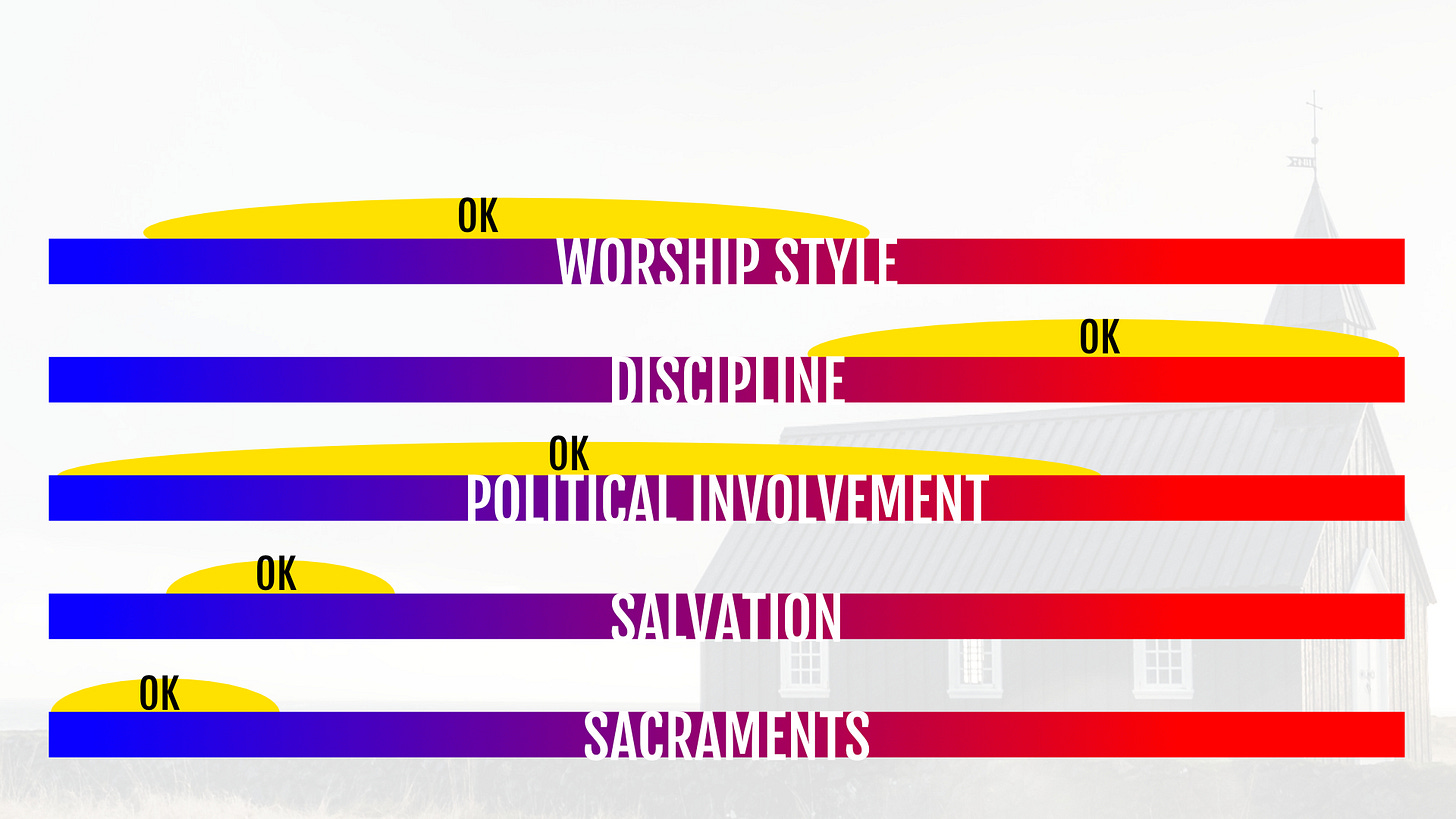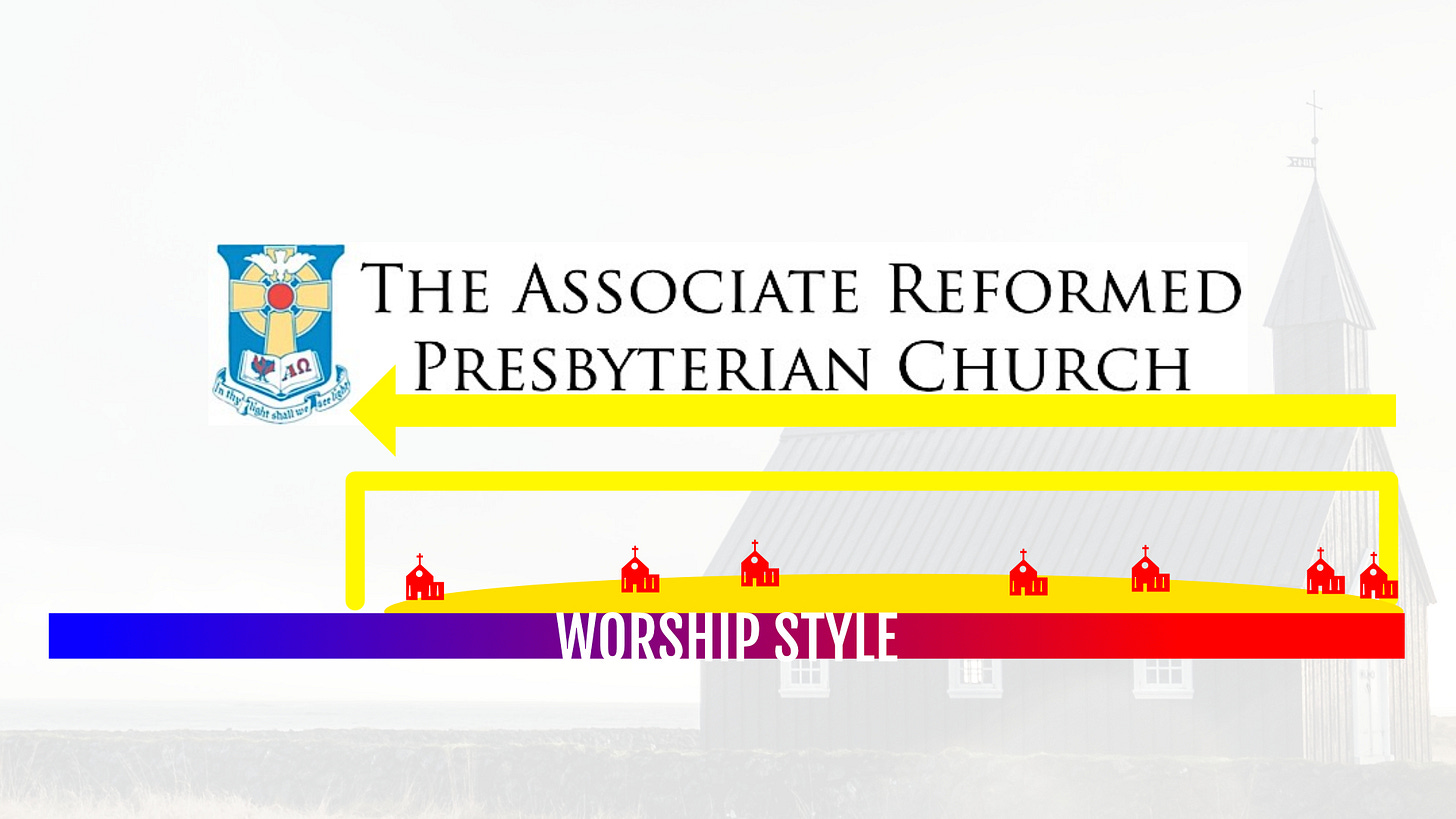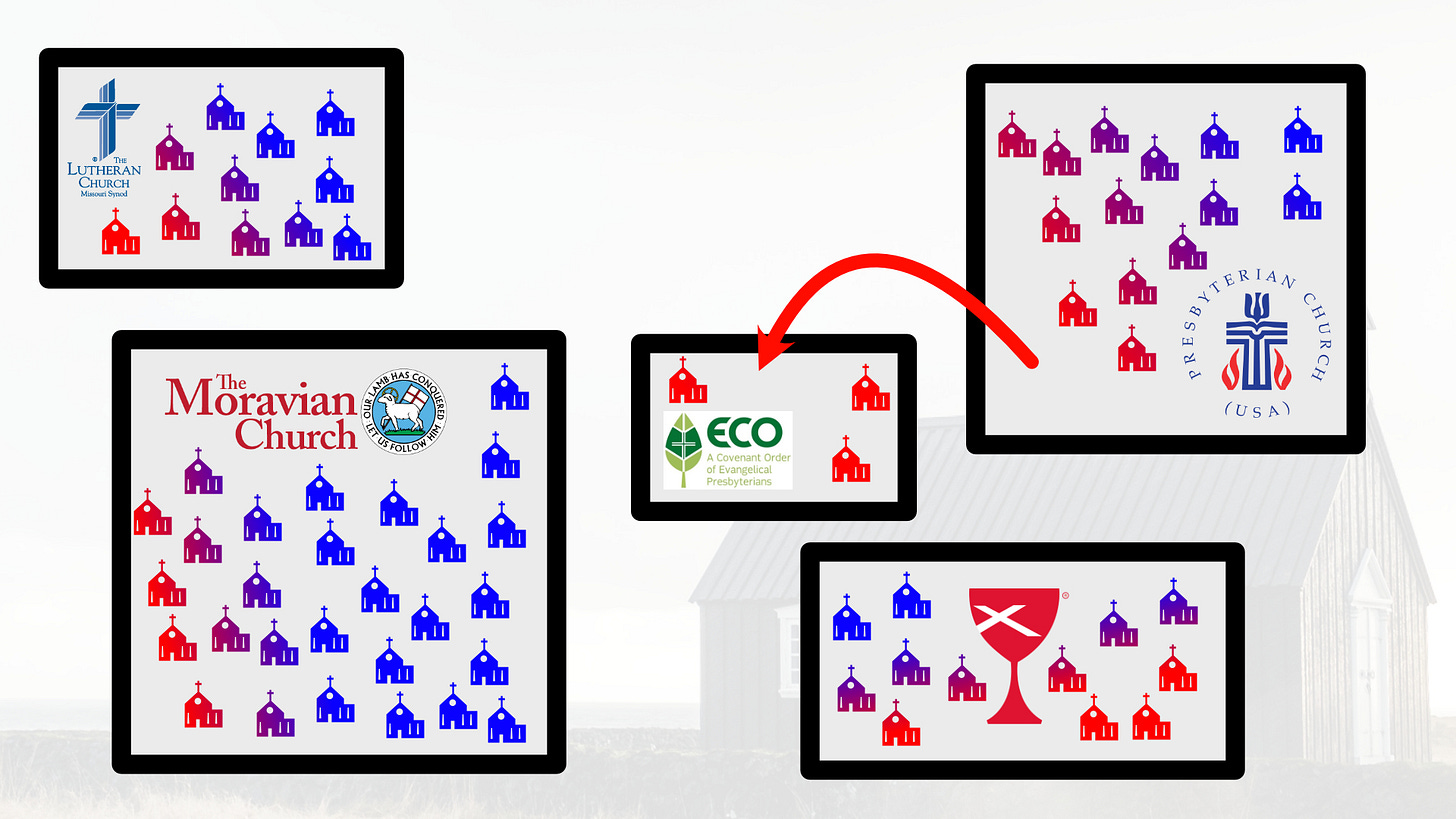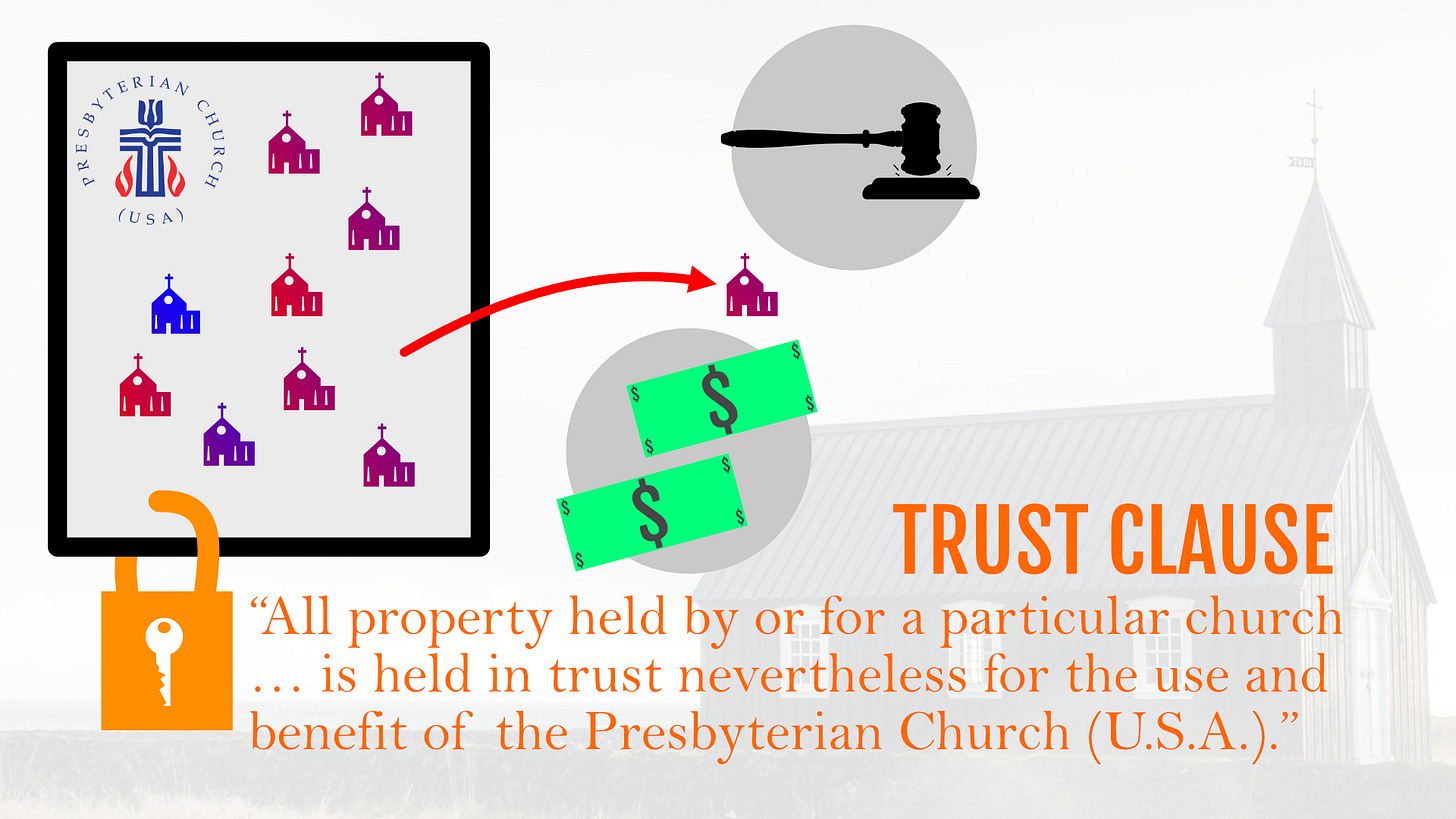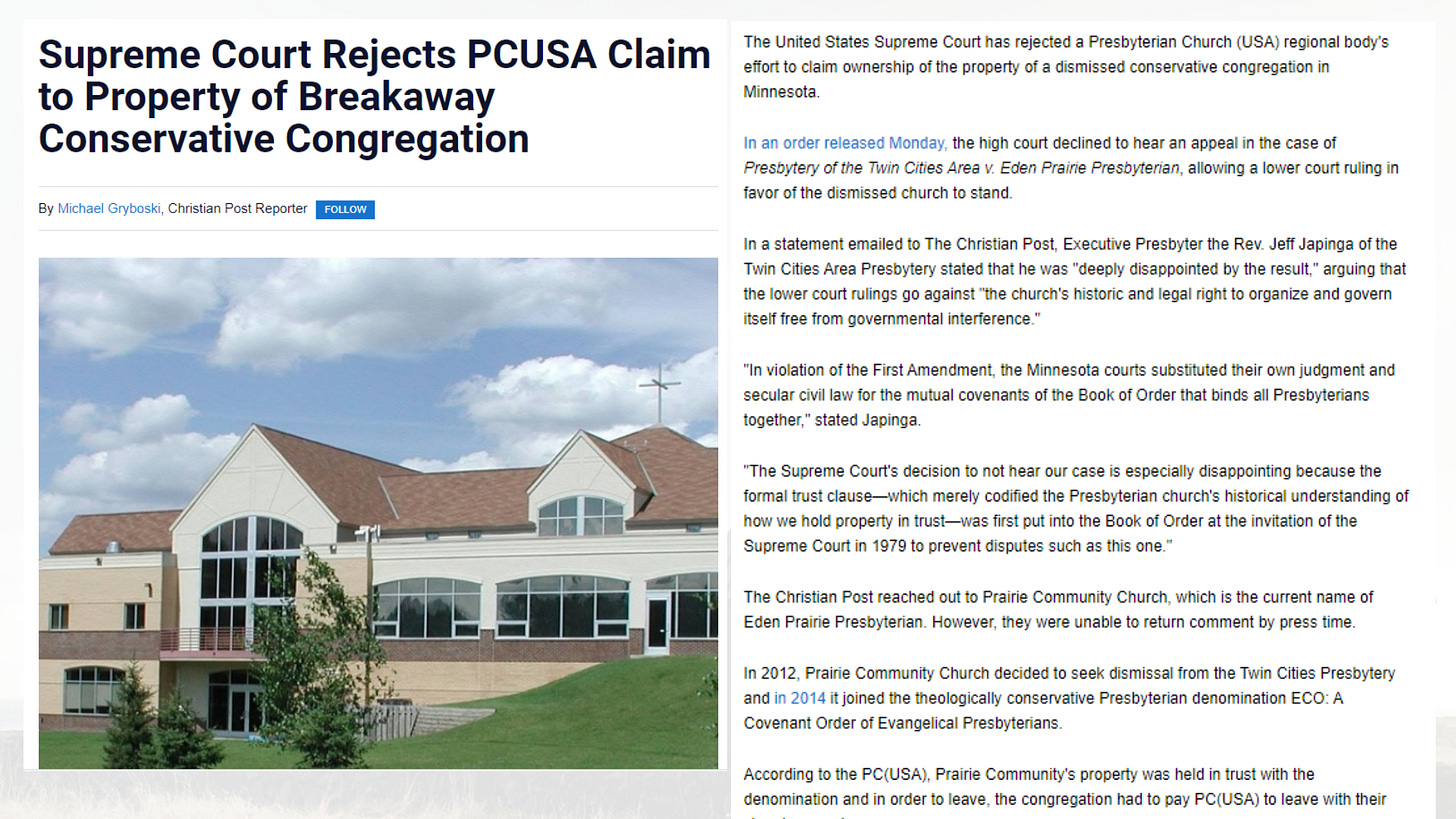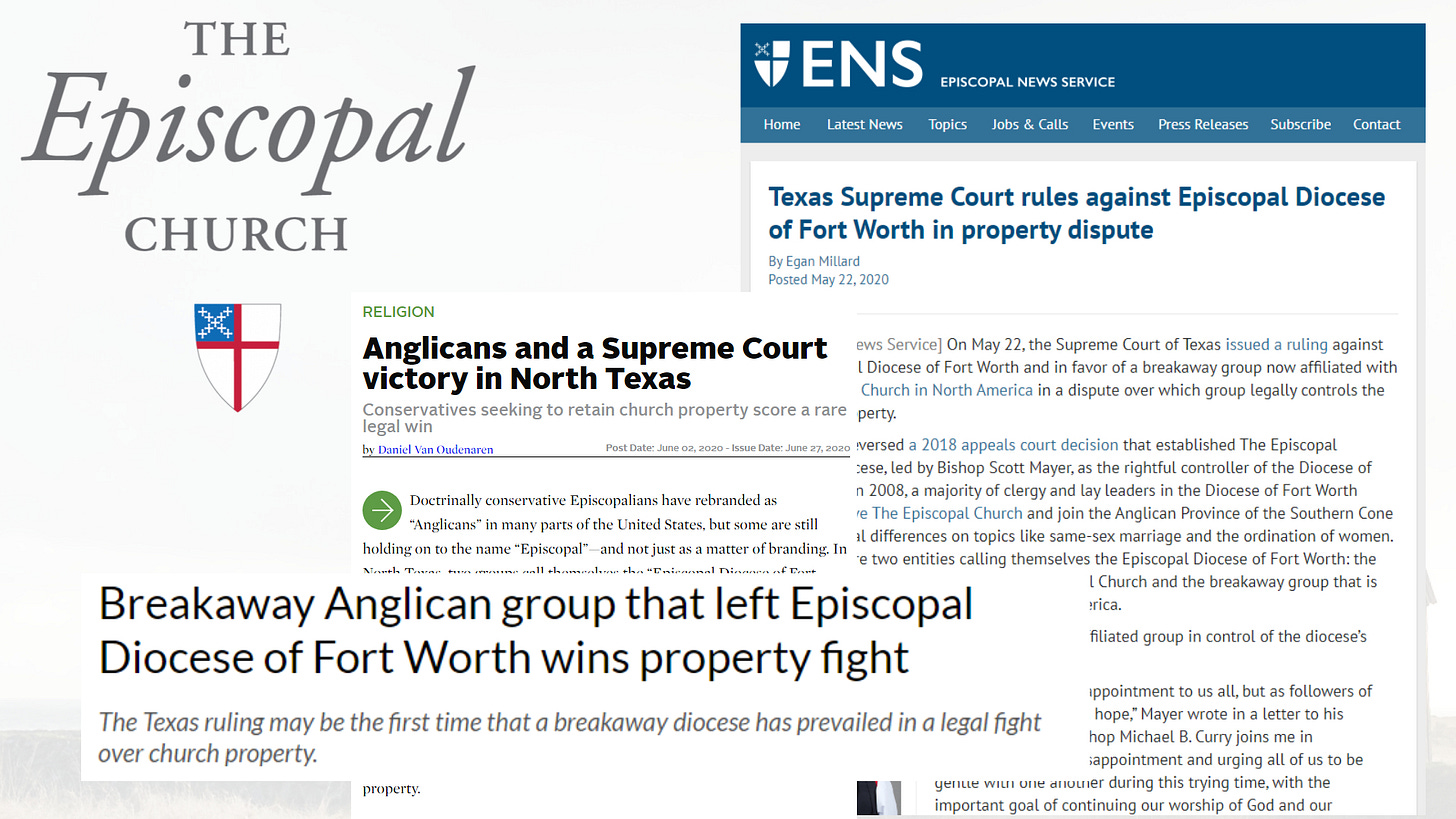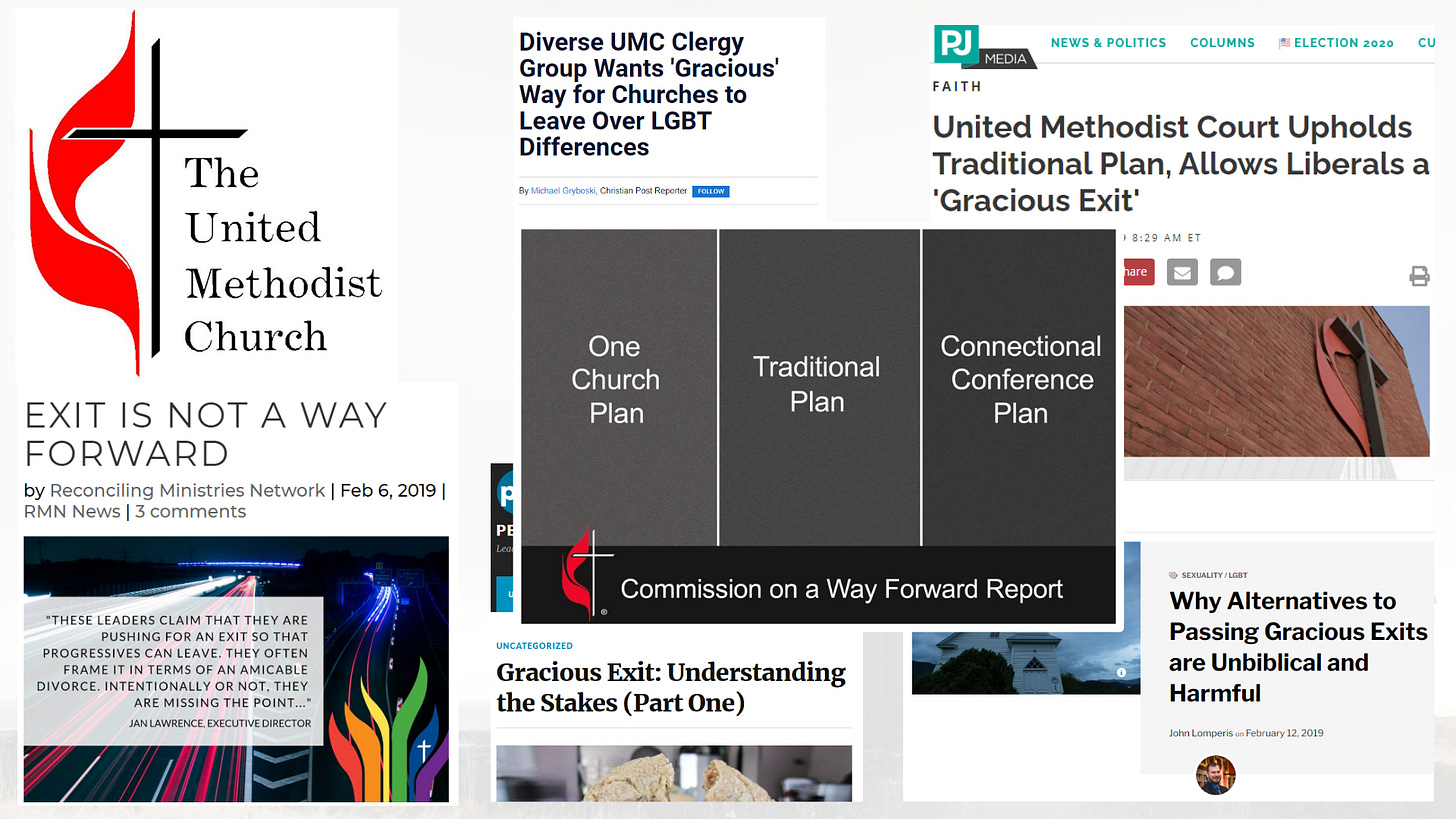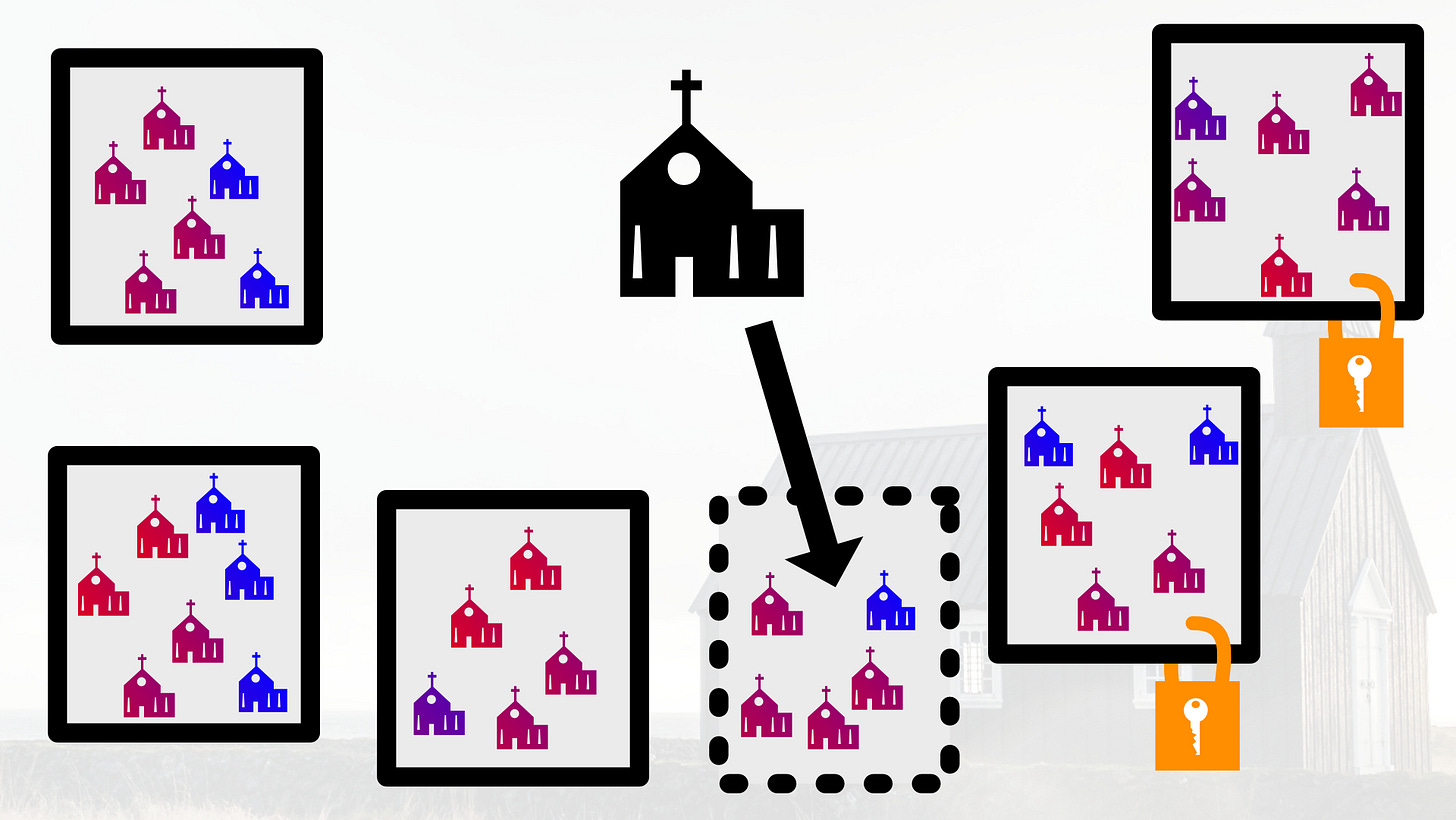Congregations Leaving Denominations: How Hard Can it Be?
It’s simple to think of denominations of Christianity as being their own little boxes, each one with consistent teaching and practice, but in reality, congregations within these denominations fit within a scale. There is a worship style scale, from “high church” or “liturgical” on the one side, to “low church” or “contemporary” on the other.
There is a scale of discipline of the membership, “hands off” at the one side, where you can do whatever you want with no repercussions, to the other side where the church enforces discipline and makes sure that members follow the rules.
On political involvement, there is a scale from apolitical to highly involved, and on political ideology there is a scale from conservative to progressive.
One could imagine many other scales on topics like views on salvation, beliefs on the sacraments, and so on. What’s important to realize though is that in each denomination, there is generally not just an acceptable point on the scale for churches to hold, but an acceptable range. Churches in some denominations may be allowed to be in a very broad range on the worship style scale. For example, in the Presbyterian Church USA, you will both find extremely high-church and liturgical congregations, and on the other side, you’ll find churches that are very contemporary and no organ in sight. And every position between is also present. In the Reformed Presbyterian Church of North America, all churches practice exclusive Psalmody – there are no contemporary-style churches, because all churches are required to only sing Biblical psalms in worship, so the acceptable range on the scale is smaller.
As the years go by, individual congregations within the denomination evolve. Sometimes most of the churches are generally evolving in the same direction on one of these scales. Maybe they are all getting more progressive in their political ideology, as happened in American mainline churches throughout the 20th century. Perhaps they are becoming more acceptable to different views on salvation, or varying opinions on the presence of Christ in the elements of communion.
So what happens as a result?
Some denominations, as congregations within them change, simply become more and more broad as they accept the full range of opinions. As time goes on, there becomes less of a distinct theology. The Associate Reformed Presbyterian Church at one time also had exclusive psalmody, but eventually they broadened. You can still be a church in the ARP with just psalmody, but if you want to have contemporary music and instruments, you can do that too. Another example is the United Methodist Church, which, in the early 21st century has had evangelical churches that baptize mostly believers by immersion and teach a born-again experience, are mostly apolitical, but whose theology on social issues is mostly conservative, opposing gay marriage and abortion for example. Their worship style is low-church, with contemporary music and pastors who don’t wear special garments. At the same time, in the same denomination there are high-church liturgical congregations that are very formal, politically progressive and affirming of the LGBT movement and gay marriage. Often they also baptize primarily infants by sprinkling, don’t teach born-again theology, and have a more frequent practice of communion.
That’s an example of broadening acceptable ranges within a denomination. Other denominations are different. Instead of loosening their book of discipline, they enforce it. Instead of requiring people to claim “essential agreement” to the confessions, they dismiss ministers who teach things that are not adherent to the literal meaning of the confessions. If a minister or congregation finds themselves outside of the acceptable range, the range doesn’t move to accommodate them, rather, they find themselves excluded. Sometimes, this means the minister is fired and replaced, and the new minster disciplines unwary members until the congregation is brought back into line. Other times, it means that when the issue comes to a head, the congregation has to leave the denomination for another one that is more fitting.
Sometimes congregations leave denominations in large blocs, either merging into existing denominations, or starting new ones. In 2011, the Presbyterian Church (USA) allowed partnered gay clergy to be ordained, one factor in the formation of a new denomination “ECO A Covenant Order of Presbyterians”, which has over 380 congregations today, mostly former PC(USA) churches
In 1976, 250 more theologically liberal churches left the Lutheran Church Missouri Synod over issues including inerrancy and desire to have women’s ordination and formed the Association of Evangelical Lutheran Churches.
So you may think that moving around is easy. Of course, it may be turbulent – there may be some in the membership who want to stay in the same denomination, and big changes create uncertainty, but if a congregation decides they need to move on, they can just do it, right?
Well, not so fast. In some cases it is just that simple, but in other cases it’s not. Let’s start with the simple. Some congregations are non-denominational, part of denominations that are only associations, or part of movements (so-called) with theological distinctives but no denominational structure. In these cases, a church can simply declare itself as withdrawn from the group, they can rename, they can do whatever they want, and nobody can say otherwise, because nobody has any jurisdiction over them.
Take Independent Baptists as an example. All that Independent Baptist means is that a church is Baptist, and also Independent. Anyone can call themselves ‘Independent Baptist’. Now, if you call yourself that, and teach something unorthodox, like nontrinitarianism, the other Independent Baptists will certainly say you aren’t Baptist any more, but they can’t stop you from calling yourself that. There’s no governing body or organization. Local congregations ordain their own ministers and set their own rules. So if a church that is Independent Baptist wants to become Methodist, all they have to do is change their name (and presumably change their doctrine too.)
In the same way Churches of Christ also have no central body, and there are independent Methodist churches, Bible churches, Brethren Churches, and so on.
For associations, in some cases there are denominations that are just voluntary groups that independent congregations join. If they go off doctrinally, they may end up being kicked out, but if they want to leave nobody can force them to stay in. Examples would be Vineyard Churches, Southern Baptist Churches, IFCA International (Formerly Independent Fundamental Churches of America) and the Association of Free Lutheran Congregations.
But let’s look at two other cases: There are denominations which hold the rights to the property of the congregations, and have strict requirements for withdrawal. Perhaps the church must vote to leave with a certain percentage, or perhaps they must buy their property from the denomination to leave. If they try to leave without doing this, the denomination can sue for their property.
And in some denominations, there is no recognition of a church being able to leave at all.
I mentioned Vineyard Churches as a denomination that allows congregations to leave at will. Here’s what one of their documents says about that:
“Vineyard Churches is not a structure which has (or wants) legal jurisdiction in the local Vineyard
We have assumed that if we have spiritual authority borne out of relationship, we don’t need legal authority. And if we don't have spiritual authority, we don’t want legal authority!
We want to work with those who want to work with us. We don’t want to work with those who don’t want to work with us. The former are permitted to use the trademark name “VINEYARD" to describe their ministry/church. The latter are required by Vineyard Churches to discontinue their use of the trademark name “VINEYARD" to describe their ministry/church.”
In Vineyard Churches, the denomination won’t try to stop a church that wants to leave. But now let’s look at the Presbyterian Church (USA). The PCUSA claims rights to all of the property of all of their congregations. The so-called “trust clause” in their book of order says “All property held by or for a particular church … is held in trust nevertheless for the use and benefit of the Presbyterian Church (U.S.A.).”
In many cases, churches that have voted to leave the PCUSA have either been sued or have entered into settlements with the denomination to be allowed to leave with their property. In 2016, First Presbyterian Church in San Antonio voted 87% to leave the PC(USA) for ECO, and ended up settling with the PCUSA for $1,525,000 to keep their property.
The 4,000 member Menlo Park Presbyterian Church in 2014 voted 93% to leave the PC(USA) and paid $8,890,000 to keep their property.
Other churches leaving the PCUSA have refused to settle, leading to lengthy court cases. Eden Prairie Presbyterian Church in Minnesota left PCUSA in 2012 and joined ECO in 2014, and was hit with a lawsuit from PCUSA. Finally in 2017 the church won the case at the Minnesota Supreme Court, and the US Supreme Court refused an appeal, leading to the church keeping their property, only because they had joined PCUSA before the trust clause was added to the book of order, and because their church had retained the right in their constitution to revoke the trust.
Some churches have left the PCUSA without much of a problem at all, because the presbytery to which they belonged was more sympathetic, and simply voted to dismiss them with agreements about the church supporting the presbytery. But other presbyterieschoose not to. When a church votes to leave but not unanimously (unanimous votes being exceedingly rare), the faction that chooses to stay in the PC(USA) is generally given the right to the whole of the property. So even if 90% vote to leave, the 10% that stay behind get to keep the now oversized buildings. Only in the case of a sympathetic presbytery, a victorious court case, or a costly settlement will the church be able to leave and hold on to their buildings.
Similarly, as churches have sought to exit the Episcopal Church even to the present, they are often sued for their property, as is the case with the Episcopal Diocese of Fort Worth, which exited the Episcopal Church for the Anglican Church in North America. The case over their $100 million in property went all the way to the Texas Supreme Court.
And in the United Methodist Church, the same has happened. In 2017, Camp Verde Community Church left the UMC, but after losing in court, in April 2020 they vacated their property which now belongs to the denomination. The UMC split after the Global UMC General Conference voted to retain wording in the book of discipline that says homosexuality is sinful, while the United States UMC congregations are majority opposed to retaining the wording. One of the big questions that was being asked as some of the details were worked out on a way forward over the past five years was whether the UMC would do the same thing as some of these other mainline denominations and fight tooth and nail against those who wanted to leave. The big topic was that of a “gracious exit” – one that allows anyone who wants to leave the UMC after the final decision on the wording on homosexuality to do so without any fighting. Of the three options presented at the 2019 General Conference of the UMC regarding keeping or removing the wording, only the “traditional plan”, which kept the wording, and ultimately passed, had a “gracious exit” built in. In other words, because that plan passed, those who accept LGBT clergy and marriages and want out can leave without a problem. However, if the “One Church Plan” had passed, which removed the wording, those who wanted to leave the church because they were opposed to LGBT clergy and Marriages may have been forced from their church property, if a negotiation for gracious exit wasn’t finalized.
In some denominations, there are simply requirements for leaving the denomination, which if met, allow the congregation to exit.
Back in 2005, Bethel Church in Redding, California voted to leave Assemblies of God and became independent. However, they messed up and held the vote before having the district leadership of the AG come and speak to the membership. Realizing their mistake, they withdrew the withdrawal, invited the district leadership, and held a re-vote. Nothing changed, and this time they withdrew for good.
In other denominations, the denomination is explicit that you can’t leave at all. In the Church of God (Cleveland Tennessee) the denomination says the following:
The Church of God (Cleveland, Tennessee, U.S.A.) has a centralized (by legal definition "hierarchical") form of church government. The International General Assembly, the highest authority of the Church of God, governs the ownership of all church property, both real and personal. All property is held in trust for members composing said International General Assembly.
…the right of any local church as a whole to withdraw from the International General Assembly is not recognized and does not exist, but those members who prove disloyal to the government and teachings as promulgated from time to time by the International General Assembly, or who are otherwise disorderly, are to be dealt with as individuals.
From this it seems that if a congregation wants to leave, the denomination will dismiss members and ministers who push for it out of the congregation until everyone that is left is content to stay.
As was mentioned, this is a hot issue right now. Churches are leaving denominations, independent congregations and non-denominational churches are more popular than ever before. In 2016, for the first time in a decade, property disputes became the most common reason for church lawsuits, surpassing lawsuits over child abuse. But as churches leave their denominations, if they decide to join another, most are picking denominations that keep their hands off of the local congregations’ property. So perhaps, in another decade or two, when a new fight arises, and these churches leave again, they’ll have it a bit easier this time.
View this post as a video on the Ready to Harvest YouTube Channel Here




